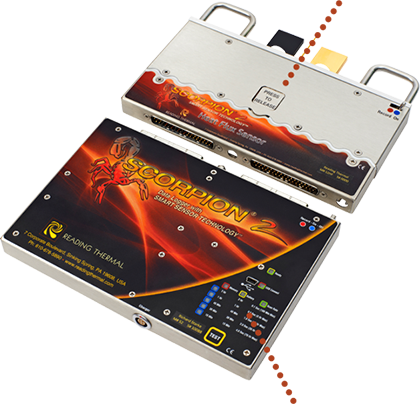Temperature monitoring during your commercial bread, bun, and snack manufacturing process will help you make reliable data-based decisions about your processes and products. Explore the state-of-the-art Reading Thermal SCORPION® 2 Profiling System to learn how it can help..
Located in Sinking Spring, Pennsylvania, Reading Thermal has focused on measuring and understanding the commercial baking process for over 25 years. We manufacture the SCORPION® 2 Profiling System and Data Logger, which is a standard in the baking industry and offers you an easy way to monitor actual oven in-process conditions.
Connecting our different smart sensors and sensor arrays to the SCORPION® 2 Data Logger and passing them through the oven with your product enables the system to capture the four main baking parameters: temperature (including the temperature of both the air and the oven belt surface), heat flux (energy transfer), humidity, and airflow (velocity).
Why Measure Oven Temperature
Oven temperature causes physical and chemical reactions in dough/batter, and temperatures that are too low or too high during baking can lead to changes in fermentation and humidity levels and undesirable changes in surface coloring, texture and flavor.
If you produce bread, artisan bread, rolls, buns, cakes, biscuits, or other bread products, you understand that several stages of the process are temperature-dependent, such as oven-spring, drying/dehydration, and color formation.
Too much heat from one direction in the oven can cause the bottoms of the loaves to burn before the crusts brown properly. An oven that is too cool usually produces a heavy and unappealing loaf with a pale or soft crust.
Our state-of-the-art profiling system also provides an easy way to validate your kill step for food safety and FSMA compliance. FSMA requires commercial bakeries to provide validation of process controls, or thermal kill steps, in an effort to reduce food borne pathogens, such as Salmonella spp, in ingredients and finished products.
How to Measure Oven Temperature
The SCORPION® 2 Temperature Sensor Array is designed to measure temperature at product level, in fixed positions across the conveyor, and deliver a true representation of what your product is experiencing over time.
Different types of pluggable sensors are available, including one designed for solid or tight mesh conveyors and one for open mesh conveyors:
- Type A: This Air/Conveyor sensor is designed to measure air temperature immediately above the conveyor, and the surface temperature of the conveyor itself. It is designed for solid or tight mesh conveyors. One thermocouple in each pair measures air temperature while the other is spring-loaded down onto the conveyor surface.
- Type B: This Air/Air sensor measures upper air temperature immediately above the conveyor, and the temperature of the lower air that is rising through the conveyor. It was created for open mesh conveyors. The upper and lower thermocouples are separated by a thin shield.
The sensor array is connected to the SCORPION® 2 Data Logging Measurement System and travels through the oven with the product, yielding a precise picture of temperature from side-to-side and end-to-end.
Improve your commercial bread, bun, and snack manufacturing process by temperature monitoring with the SCORPION® 2 Profiling System from Reading Thermal. Contact us online, or call us at (610) 678-5890 Ext. 2 to learn more.

